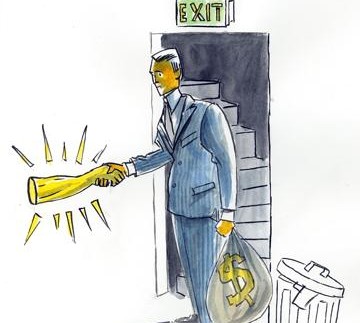Why it’s worth reintroducing the golden handshake

Whatever happened to the termination payout as a viable staff management practice? In the era of modern human resource practice, the mutually agreed payout seems to be an outdated methodology. But should it be?
Consider the options.
Someone in your workforce is either actively disengaged, willfully underperforming or a poor cultural fit, so we try seemingly never-ending rounds of appeasement strategies – mostly with little to no effect on the situation.
Here’s a tip. If they’ve had one or two rounds of coaching over underperformance (and this is always the first option!) with little or no change in their work output or attitude, perhaps it’s time to consider the process of redundancy. Make it a mutually agreeable compensation figure for their time at work, and move them on. They walk away happy, and you are also happy because that chapter is closed and you can move on to focusing your energy on productive, engaged staff.
Here are two reasons why the termination payment works.
1.From a bottom line perspective, the cost of paying someone out is a cheap investment compared to the ongoing underperformance and the impact that has on the wider team. Do the sums. If someone’s on $80,000pa and operating at 50 per cent of their capacity and you keep them on for the next two years, then add to this the impact of lowered productivity on the wider team, it might be costing you in excess of $100,000 over a two-year period. Stats from the Society of Knowledge Economics’ paper on comparing high-performing workplaces (HPW) in Australia against low-performing workplaces showed HPW employees are worth $40,000 more profit per person. To terminate someone with a $10,000 to $40,000 handshake makes economic sense.*
2.From a health perspective, you might be putting years on the lifespan of both the employee and the manager. High stress coupled with long periods of exposure has marked effects on our long-term wellbeing. Letting people move on with their lives and find happier places is a win-win on so many levels from a health perspective.
* Now, some people reading this article might wonder about people in their organisation who might deliberately start underperforming to get paid out. If that’s a reality, you’re still in front. Move them on and replace them with people who see a purpose in their work beyond the pay cheque, and work damn hard on fixing the culture that created the option in the first place.
Re-engineering the pay-to-leave process
Zappos, the revolutionary customer service culture champion, has reverse-engineered the payout to great effect. It actually offers every employee a payout figure of $4000 in their first week of employment! That’s right, part of the way through a new Zappos employee’s induction, they table the offer of 4K to walk away, no strings attached. Their reasoning? If people are working for the pay only, then they aren’t a cultural fit.
This offer has been adopted by Zappos’ parent company, Amazon, which has started a ‘Pay to Quit’ program that raises by $1000 per year to a maximum of $5000. Whilst there’s little doubt this type of policy wouldn’t be a perfect fit for many organisations, it does allow us to consider an innovative approach to what is an endemic problem.
As an industry, human resources is filled with highly intelligent, well-meaning practitioners with a humanistic tendency to give everyone every possible chance to rectify or remedy substandard working processes. It’s both honourable and admirable. But in all areas of life, sometimes ending a relationship is the greatest respect you can pay the other person. Perhaps it’s time for organisations to rethink the payout, just like Zappos and Amazon have done so successfully.
*Source: http://www.brw.com.au/p/leadership/why_it_worth_reintroducing_the_golden_pAi98GjRZEyGUKZlp1SsSK

